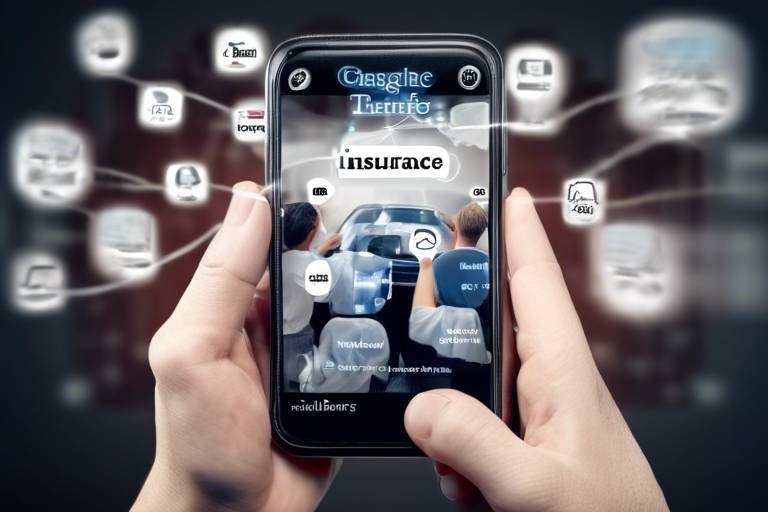The Future of Augmented Reality in Real Estate
As technology continues to evolve, the real estate industry is on the brink of a major transformation, largely driven by augmented reality (AR). Imagine walking through a property without ever stepping foot inside it, or being able to visualize how a space would look with your personal touch. This isn't just a dream; it's becoming a reality. The integration of AR into real estate is set to revolutionize how we buy, sell, and experience properties. In this article, we will dive into the myriad ways AR is enhancing property visualization, streamlining the buying process, and improving marketing strategies, while also addressing the challenges that come with this innovative technology.
Augmented reality is changing the game when it comes to how potential buyers visualize properties. Gone are the days of flipping through static images or relying solely on traditional open houses. With AR, buyers can immerse themselves in listings through interactive 3D environments. This technology allows them to explore every nook and cranny of a property, making the decision-making process not only faster but also more informed. Imagine being able to walk through a home, see how the sunlight filters through the windows at different times of the day, or even get a feel for the neighborhood—all from the comfort of your couch!
AR technology simplifies the real estate buying process significantly. It provides clients with interactive tools that enable them to tour properties remotely, which reduces the time spent on physical visits and enhances convenience. For instance, instead of scheduling multiple viewings, a buyer can use AR to quickly assess several properties in one go. This is not just about saving time; it’s about creating a more efficient and enjoyable experience for everyone involved.
With AR, virtual tours can replicate the experience of an open house, allowing buyers to explore properties in detail from anywhere. This means that even if a buyer is across the country or globe, they can still engage with listings in a meaningful way. It's like having a personal guide who can show you around without the need for travel. Increased accessibility leads to heightened engagement, making it easier for buyers to connect with their future homes.
Another exciting application of AR is the use of interactive floor plans. These innovative tools allow buyers to visualize room dimensions and layouts in real-time. Imagine being able to see how a couch fits in the living room or how a dining table would look against the wall—all before making any commitments. This capability not only facilitates a better spatial understanding but also opens the door for customization options, empowering buyers to envision potential modifications.
One of the most thrilling aspects of AR is the ability for users to manipulate property features in real-time. Want to change the wall color from beige to a vibrant blue? Or perhaps rearrange the furniture to create a cozier atmosphere? With AR, these changes can be visualized instantly, allowing buyers to envision their future home more clearly. This level of interactivity can significantly influence purchasing decisions, making the buyer feel more connected to the property.
Real estate agents are also leveraging AR in their marketing strategies, creating engaging advertisements that capture attention and provide immersive experiences for potential clients. Instead of traditional flyers or static online listings, agents can offer experiences that allow buyers to interact with properties in a novel way. This not only sets them apart from the competition but also makes the entire process more enjoyable for buyers.
Despite its many advantages, the integration of AR in real estate does face some challenges. High costs, technological barriers, and the need for user education are significant hurdles that must be addressed to ensure widespread adoption.
Implementing AR technology can be expensive for real estate firms. The substantial investment required for software, hardware, and training can deter smaller businesses from adopting it. However, as technology advances and becomes more affordable, we may see a shift that allows more players in the market to take advantage of these tools.
Another challenge is that not all clients may have access to the necessary technology or internet speeds to utilize AR effectively. This creates a gap in service delivery and limits the reach of AR applications. As we move forward, addressing these barriers will be crucial for ensuring that AR can benefit everyone in the real estate market.
- What is augmented reality in real estate?
Augmented reality in real estate refers to the use of technology to overlay digital information, such as 3D models or interactive features, onto the real world, enhancing the property viewing experience. - How does AR improve the home buying process?
AR allows buyers to visualize properties in immersive ways, conduct virtual tours, and make informed decisions without the need for multiple physical visits. - What are the main challenges of using AR in real estate?
The main challenges include high implementation costs, technological barriers for clients, and the need for user education to ensure effective usage.

Enhancing Property Visualization
This article explores the transformative potential of augmented reality (AR) in the real estate sector, examining its applications, benefits, and challenges while envisioning a tech-driven future for property transactions.
Imagine stepping into a world where you can walk through your future home without ever leaving your couch. Augmented reality (AR) is making this dream a reality by revolutionizing how potential buyers visualize properties. With AR, listings come alive in immersive 3D environments, allowing buyers to experience the space as if they were physically present. This technology not only makes property viewing more engaging but also helps clients make faster and more informed decisions.
One of the most exciting aspects of AR in real estate is the ability to create virtual staging. Instead of relying on empty rooms, agents can showcase fully furnished spaces that highlight the property’s potential. This means that buyers can see how their furniture might fit into the layout, helping them to visualize their future life in that space. It’s like painting a picture of possibilities right before their eyes!
Furthermore, AR can enhance property visualization through interactive features. Buyers can zoom in on details, change color schemes, or even rearrange furniture with a simple tap on their devices. This level of interactivity not only captivates the audience but also allows them to customize their viewing experience. Imagine being able to change a room's wall color from beige to a vibrant blue with just a swipe—suddenly, the house feels like it could be your home.
To illustrate the impact of AR on property visualization, consider the following table that compares traditional property viewing methods with AR-enhanced experiences:
| Aspect | Traditional Viewing | AR-Enhanced Viewing |
|---|---|---|
| Experience | Physical visit to the property | Immersive 3D experience from anywhere |
| Customization | Limited to what is physically present | Real-time modifications of decor and layout |
| Accessibility | Requires travel to the property | Accessible from mobile devices or AR glasses |
| Time Efficiency | Time-consuming with multiple visits | Quick and efficient, view multiple properties in one session |
In summary, augmented reality is not just a gimmick; it’s a powerful tool that enhances property visualization in ways we never thought possible. It transforms the tedious process of house hunting into an exciting adventure, where buyers can explore, interact, and envision their future homes without the usual constraints of time and location. As AR technology continues to evolve, we can only anticipate even more innovative applications that will further enrich the real estate landscape.
AR technology simplifies the real estate buying process by providing interactive tools that enable clients to tour properties remotely, reducing time spent on physical visits and enhancing convenience.
With AR, virtual tours can replicate the experience of an open house, allowing buyers to explore properties in detail from anywhere, increasing accessibility and engagement.
Interactive floor plans integrated with AR allow buyers to visualize room dimensions and layouts, facilitating better spatial understanding and customization options for potential modifications.
Users can manipulate property features in real-time, such as changing wall colors or furniture arrangements, enabling them to envision their future home more clearly.
Real estate agents can leverage AR in their marketing strategies, creating engaging advertisements that capture attention and provide immersive experiences for potential clients.
Despite its advantages, the integration of AR in real estate faces challenges such as high costs, technological barriers, and the need for user education to ensure widespread adoption.
Implementing AR technology can be expensive for real estate firms, requiring substantial investment in software, hardware, and training, which may deter smaller businesses from adopting it.
Not all clients may have access to the necessary technology or internet speeds to utilize AR effectively, creating a gap in service delivery and limiting its reach.
- What is augmented reality in real estate?
Augmented reality in real estate refers to the use of AR technology to enhance property viewing experiences, allowing buyers to visualize properties in immersive 3D environments. - How does AR improve property visualization?
AR allows buyers to interact with properties, customize features in real-time, and experience fully furnished spaces without physically visiting them. - Are there challenges to using AR in real estate?
Yes, challenges include high implementation costs, technological barriers, and the need for user education to ensure effective use.

Streamlining the Buying Process
Imagine walking through your dream home without ever leaving your couch. Sounds like a scene from a sci-fi movie, right? Well, augmented reality (AR) is making this a reality in the real estate sector! AR technology is revolutionizing the way we buy properties, making the entire process not just easier but also more engaging. With interactive tools at their fingertips, buyers can now explore properties remotely, which significantly reduces the time spent on physical visits. This is especially beneficial for those who are juggling busy schedules or live far away from their desired locations.
One of the standout features of AR in real estate is the ability to conduct virtual tours. These immersive experiences replicate the feel of an open house, allowing potential buyers to wander through properties at their own pace. They can zoom in on details, examine the layout, and even get a sense of the neighborhood—all from the comfort of their homes. This level of accessibility can increase engagement, as buyers feel more connected to the properties they are considering.
But it doesn't stop there! AR also enhances the buying process through interactive floor plans. These tools allow buyers to visualize room dimensions and layouts in a way that traditional photos simply cannot. Imagine being able to see how your furniture would fit in a space or how a room looks when you change the wall color—this is the power of AR! Buyers can better understand the spatial dynamics of a property and even explore customization options before making a commitment.
Furthermore, real-time property modifications take the experience to the next level. Users can manipulate various features of a property as they explore it. Want to see how that bright blue paint looks instead of the current beige? Or perhaps you want to rearrange the living room furniture to see if it flows better? AR makes these alterations possible, providing a clearer vision of what their future home could look like. This not only helps in decision-making but also fosters a sense of ownership even before the purchase is made.
In summary, AR is not just a flashy gimmick; it’s a game-changer in streamlining the buying process. By making property exploration more interactive and engaging, it empowers buyers to make informed decisions faster than ever before. The future of real estate transactions is here, and it’s looking brighter and more immersive than we ever imagined!
- What is augmented reality in real estate? - Augmented reality (AR) in real estate refers to technology that overlays digital information, such as 3D models and interactive features, onto the real world, enhancing the property viewing experience.
- How does AR streamline the buying process? - AR streamlines the buying process by allowing buyers to take virtual tours, view interactive floor plans, and make real-time modifications to properties, all of which save time and enhance decision-making.
- Can I use AR on my mobile device? - Yes! Many AR applications are designed to be compatible with smartphones and tablets, making it easy for users to explore properties on-the-go.
- Are there any costs associated with using AR in real estate? - While many AR experiences are free for buyers, real estate firms may incur costs for developing and implementing AR technology.

Virtual Tours and Open Houses
Imagine being able to explore your dream home without ever leaving your couch. Sounds like science fiction, right? Well, welcome to the world of augmented reality (AR), where virtual tours are revolutionizing how we experience real estate. With AR technology, potential buyers can step inside a property from anywhere in the world, making the traditional open house feel like a relic of the past. This innovative approach not only enhances the buying experience but also makes it more accessible and engaging.
Virtual tours powered by AR replicate the feeling of walking through a house. They allow prospective buyers to interact with the space in a way that static images simply can’t achieve. Imagine being able to look out of the living room window and see the view, or being able to walk through the kitchen and check out the layout as if you were actually there. This immersive experience can significantly impact a buyer's decision-making process, allowing them to visualize themselves in the space.
Moreover, these virtual tours can be tailored to highlight the unique features of each property. For instance, if a home has a stunning garden, the AR tour can focus on that area, providing an enriched experience. Buyers can even receive additional information about the property, such as square footage and nearby amenities, enhancing their understanding of what is on offer. This level of detail not only captivates the audience but also helps them make informed decisions.
One of the most exciting aspects of virtual tours is their ability to reach a broader audience. Buyers from different geographical locations can now explore properties without the need for travel. This is particularly beneficial in today’s global market, where buyers are often looking for homes in different states or even countries. By eliminating the need for physical presence, real estate agents can cater to a diverse clientele and broaden their market reach.
However, it’s essential to note that while virtual tours are a game-changer, they also require a strong internet connection and compatible devices. Not everyone may have access to the technology needed to fully experience AR. This is where real estate professionals need to step in and ensure that their clients are educated about how to use these tools effectively. Providing tutorials or support can help bridge this gap and ensure that everyone can benefit from the virtual tour experience.
In conclusion, virtual tours and open houses powered by augmented reality are transforming the real estate landscape. They offer a unique, engaging, and immersive way for buyers to explore properties, making the process not only more enjoyable but also more efficient. As technology continues to advance, we can expect to see even more innovative applications of AR in real estate, paving the way for a future where property transactions are as seamless as they are exciting.
- What is augmented reality in real estate?
Augmented reality in real estate refers to the use of technology to overlay digital information, such as 3D models or virtual tours, onto the real world, allowing buyers to visualize properties in an immersive way.
- How do virtual tours work?
Virtual tours use AR technology to create a digital representation of a property, enabling users to explore it interactively through their devices, simulating the experience of a physical walk-through.
- What are the benefits of virtual tours for buyers?
They provide convenience, save time, enhance understanding of space, and allow buyers to view multiple properties from different locations without the need for travel.
- Are there any challenges with virtual tours?
Yes, challenges include the need for reliable internet access, compatible devices, and educating users about how to navigate the technology effectively.

Interactive Floor Plans
Imagine walking into a new home and being able to visualize every nook and cranny without stepping foot inside. make this dream a reality, transforming how potential buyers assess properties. With the power of augmented reality, these floor plans allow users to engage with the layout of a home in a dynamic, hands-on manner. Instead of just looking at static images or blueprints, buyers can manipulate the space virtually, exploring different configurations and arrangements with just a few taps on their devices.
One of the most exciting aspects of interactive floor plans is their ability to provide a realistic sense of scale. Buyers can see how their furniture would fit within the dimensions of each room, helping them determine if a space meets their needs. This is particularly beneficial for families or individuals who have specific requirements, such as a home office or a playroom. By visualizing the layout in real-time, clients can make informed decisions, potentially speeding up the buying process.
Furthermore, these interactive tools can integrate additional features that enhance the user experience. For instance, users can:
- Change wall colors to see how different shades can alter the ambiance of a room.
- Drag and drop furniture items to experiment with different arrangements.
- View the property from various angles, providing a comprehensive understanding of how the space flows.
This level of customization not only empowers buyers but also engages them in a way that traditional methods cannot. It’s like having a personal interior designer at your fingertips! By allowing potential homeowners to envision their future living space, interactive floor plans help bridge the gap between imagination and reality.
As we look to the future, the integration of interactive floor plans in the real estate market is set to revolutionize the way properties are marketed and sold. This technology not only enhances the buyer's experience but also aids real estate agents in showcasing their listings more effectively. By providing potential buyers with the tools they need to visualize their future home, agents can increase interest and reduce the time properties spend on the market.
What are interactive floor plans?
Interactive floor plans are digital representations of a property's layout that allow users to manipulate and visualize the space in real-time, providing a more engaging experience than traditional blueprints.
How do interactive floor plans benefit homebuyers?
They help homebuyers visualize room dimensions, experiment with furniture arrangements, and better understand how the space meets their needs, leading to more informed purchasing decisions.
Can I customize the floor plans?
Yes! Many interactive floor plans allow users to change colors, rearrange furniture, and view the space from different angles, giving a personalized touch to the visualization process.
Are interactive floor plans widely available?
While they are becoming increasingly popular, not all real estate listings currently feature interactive floor plans. However, their adoption is expected to grow as technology advances.

Real-Time Property Modifications
Imagine walking through a property and being able to change the wall colors, swap out furniture, or even modify the layout, all in real-time. through augmented reality (AR) are revolutionizing the way potential buyers interact with real estate. This innovative technology allows users to visualize their dream home by customizing elements on-the-fly, making the home-buying experience not just informative but also interactive and engaging.
With AR, buyers can use their smartphones or AR glasses to see how different design choices would look in a space. For instance, if you’ve always dreamed of a bright blue kitchen, you can instantly change the color of the walls with a simple swipe. This capability extends beyond just colors; it allows for a comprehensive reimagining of a space. Want to see how that oversized couch fits in the living room? Just drag and drop it in the AR environment and see if it complements the room's layout. This level of interaction not only enhances the buyer's experience but also empowers them to make more informed decisions.
Furthermore, real-time modifications can help buyers visualize potential renovations or upgrades. For example, if a buyer is considering a property but feels the layout is too cramped, they can use AR to experiment with removing walls or adding extensions. This ability to manipulate property features helps buyers to see the full potential of a home, which might not be apparent through traditional listings or even virtual tours.
However, the benefits of real-time property modifications go beyond just aesthetics. They can also play a significant role in reducing the time it takes to finalize a sale. When buyers can see their vision come to life instantly, they are more likely to feel confident in their purchase. This can lead to quicker decision-making and potentially faster transactions, which is a win-win for both buyers and real estate agents.
In summary, real-time property modifications through AR represent a significant leap forward in the real estate market. They provide a unique, engaging way for buyers to interact with properties, visualize their future homes, and make informed decisions that align with their personal tastes and needs. As this technology continues to evolve, we can expect it to become a standard part of the home-buying process, making it more accessible and enjoyable for everyone involved.
- What is augmented reality in real estate? Augmented reality in real estate refers to the use of technology to overlay digital information, such as 3D models and interactive features, onto the real world, enhancing property visualization and buyer engagement.
- How can real-time modifications benefit buyers? Real-time modifications allow buyers to customize and visualize changes in a property instantly, helping them make more informed decisions and see the potential of a space.
- Is AR technology expensive to implement? Yes, implementing AR technology can require a significant investment in software, hardware, and training, which may pose challenges for smaller real estate firms.
- Do all buyers have access to AR technology? Not all buyers may have access to the necessary technology or high-speed internet required to use AR effectively, which can limit the reach of this innovative tool.

Improving Marketing Strategies
In the fast-paced world of real estate, standing out from the crowd is more crucial than ever. Traditional marketing methods are becoming less effective, and that’s where augmented reality (AR) swoops in like a superhero. Imagine potential buyers not just looking at a flat image of a property but actually stepping into a lifelike, interactive experience right from their smartphones or tablets. This is the magic of AR, and it’s revolutionizing how real estate agents market properties.
By integrating AR into their marketing strategies, real estate professionals can create engaging and memorable experiences that resonate with clients. Think about it: when was the last time you were genuinely excited about a property listing? With AR, agents can offer immersive property showcases that allow clients to visualize homes in a way that static images simply can't achieve. This not only enhances the appeal of the property but also significantly increases the likelihood of a sale.
For instance, consider a potential buyer browsing through multiple listings. With AR, they can use their mobile device to scan a QR code on a flyer or a website link to instantly launch a virtual tour of the property. This tour can include:
- 3D walkthroughs that replicate the feel of being inside the home.
- Interactive elements that allow users to click on features for more information.
- Customizable views that let buyers see how the space would look with their own furniture.
Furthermore, AR can be a game-changer in creating targeted marketing campaigns. With data analytics, agents can tailor AR experiences based on the preferences and behaviors of potential buyers. Imagine receiving a personalized AR experience that highlights features based on your past interests—it's like having a real estate agent who knows you inside and out! This level of personalization can significantly enhance client engagement, leading to higher conversion rates.
However, it’s essential for real estate agents to be mindful of the content quality they produce. High-definition visuals and seamless interactivity are key. If the AR experience is clunky or poorly executed, it could turn potential buyers away instead of attracting them. Therefore, investing in quality AR content is vital. Additionally, agents should consider how they present these AR experiences. A well-designed landing page with easy navigation can make all the difference in keeping potential buyers engaged.
As we look to the future, it’s clear that AR isn’t just a passing trend; it’s becoming a fundamental part of real estate marketing. The ability to immerse clients in a property experience before they even step foot inside is a powerful tool that can lead to quicker sales and happier clients. So, whether you’re a seasoned agent or just starting in the industry, embracing AR technology could be your ticket to staying ahead in this competitive market.
Q1: How can augmented reality enhance my property listing?
AR allows potential buyers to engage with your property listings in an interactive way, providing immersive experiences that static images cannot replicate. Buyers can visualize the space, making them more likely to pursue the property.
Q2: What technology do I need to use AR in real estate marketing?
Most clients will need a smartphone or tablet with AR capabilities, along with a stable internet connection. Real estate agents should also invest in quality AR software to create engaging content.
Q3: Is AR technology expensive to implement?
While there are costs associated with implementing AR technology, such as software and training, the potential return on investment through increased sales and client engagement can outweigh these initial expenses.

Challenges of Implementing AR
While augmented reality (AR) holds incredible promise for revolutionizing the real estate industry, it doesn't come without its challenges. The integration of this cutting-edge technology into property transactions can be a double-edged sword. For starters, cost implications can be a significant hurdle. Many real estate firms, especially smaller ones, may find the initial investment in AR technology daunting. This includes not only the price of software and hardware but also the costs associated with training staff to use these new tools effectively. Imagine trying to sell a house and being unable to afford the very technology that could make your listings shine!
Moreover, technological barriers can impede the adoption of AR in real estate. Not every potential buyer has access to the latest devices or high-speed internet, which are essential for a smooth AR experience. This disparity can create a gap in service delivery, where some clients can enjoy immersive property tours while others are left behind. It's like trying to watch a blockbuster movie on a tiny screen with a slow connection—frustrating and far from the intended experience!
Furthermore, there's a need for user education to ensure widespread adoption of AR technology. Many clients may not be familiar with how AR works or its benefits, leading to skepticism about its effectiveness. Real estate agents and firms must invest time and resources into educating their clients, which can be a lengthy process. Think of it as teaching someone how to ride a bike; it takes patience, practice, and a bit of encouragement to get them comfortable enough to pedal on their own.
In addition to these challenges, there are also concerns about data privacy and security. As AR applications collect and utilize personal data to enhance user experience, clients may worry about how their information is being handled. Real estate firms must prioritize transparency and security measures to build trust with their clients. After all, no one wants to feel like their personal information is up for grabs while they’re exploring their dream home!
In summary, while the challenges of implementing AR in real estate are significant, they are not insurmountable. By addressing cost implications, overcoming technological barriers, educating users, and ensuring data security, the real estate sector can pave the way for a more immersive and engaging future. The key is to embrace these challenges as opportunities for growth and innovation, ultimately transforming how we buy and sell properties.
- What is augmented reality in real estate?
Augmented reality (AR) in real estate refers to the use of technology to overlay digital information, such as 3D models of properties, onto the real world, enhancing the way buyers experience listings.
- How can AR improve property visualization?
AR allows potential buyers to visualize properties in immersive 3D environments, helping them make faster and more informed decisions about their purchases.
- What are the main challenges of using AR in real estate?
The main challenges include high costs of implementation, technological barriers for clients, the need for user education, and concerns about data privacy and security.

Cost Implications
Implementing augmented reality (AR) technology in the real estate sector comes with a set of significant financial considerations. For many real estate firms, especially smaller ones, the initial investment can feel like climbing a steep hill. The costs associated with AR technology can be broadly categorized into several key areas:
- Software Development: Creating custom AR applications tailored to specific property listings requires skilled developers. This can range from a few thousand to tens of thousands of dollars, depending on the complexity.
- Hardware Investments: To fully leverage AR, firms may need to invest in high-performance devices such as tablets or headsets, which can add to the overall cost.
- Training and Support: Employees must be trained not only to use AR tools but also to integrate them into their existing workflows. This training often requires additional resources and time, which can strain budgets.
Moreover, the ongoing maintenance of AR systems can also pose financial challenges. Regular updates and troubleshooting are essential to keep the technology running smoothly and to ensure it remains relevant in a rapidly evolving tech landscape. Firms need to consider these recurring costs in their budgeting strategies.
Despite these financial hurdles, the potential return on investment (ROI) from adopting AR can be substantial. Enhanced property visualization can lead to quicker sales cycles and higher customer satisfaction. In fact, studies have shown that properties featuring AR experiences can sell up to 30% faster than those without. This potential for increased sales can help offset the initial costs and make AR a worthwhile investment in the long run.
In conclusion, while the cost implications of implementing AR in real estate can be daunting, the benefits it brings to the table—such as improved customer engagement and faster sales—can ultimately justify the expense. As the technology becomes more mainstream and accessible, it is likely that costs will decrease, making it a viable option for a broader range of real estate professionals.
- What is augmented reality in real estate?
Augmented reality in real estate refers to the use of digital technology to overlay virtual information or images onto the real world, enhancing property visualization for potential buyers. - How can AR benefit buyers?
AR allows buyers to take virtual tours, view interactive floor plans, and even modify property features in real-time, making the buying process more engaging and informed. - Are there significant costs associated with AR?
Yes, implementing AR technology involves costs related to software development, hardware, and training, which can be substantial for real estate firms. - Is AR technology widely accessible?
While AR is becoming more popular, not all clients may have access to the necessary devices or internet speeds, which can limit its reach.

Technological Barriers
While augmented reality (AR) has the potential to revolutionize the real estate industry, there are significant that can hinder its widespread adoption. One of the primary challenges is the disparity in access to technology among potential buyers. Not everyone has the latest smartphones or AR-compatible devices, which can create a digital divide. Imagine wanting to explore your dream home but being unable to do so because your device simply doesn't support the necessary applications. This scenario is more common than you might think.
Moreover, the effectiveness of AR is heavily reliant on internet connectivity. In areas where high-speed internet is not available, users may experience lag or even be unable to use AR applications altogether. This limitation can frustrate potential buyers and lead to missed opportunities for real estate agents. It's akin to trying to watch a high-definition movie on a dial-up connection; the experience is far from enjoyable and often leads to abandonment.
Additionally, there is a learning curve associated with new technology. Many clients, particularly older generations, may not feel comfortable navigating AR applications. They might find the technology overwhelming or confusing, which can deter them from engaging with these innovative tools. It's essential for real estate firms to provide adequate training and support to help clients become familiar with AR. Without this, the potential benefits of AR could be lost on those who need it the most.
To further illustrate these points, consider the following table that summarizes the technological barriers faced in implementing AR in real estate:
| Barrier | Description |
|---|---|
| Device Accessibility | Not all users have access to AR-compatible devices, limiting engagement. |
| Internet Connectivity | High-speed internet is essential for an optimal AR experience; lack of it can hinder usability. |
| User Comfort | Some clients may struggle with new technology, requiring additional support and training. |
In conclusion, while the excitement surrounding AR in real estate is palpable, it's crucial to address these to ensure that all potential buyers can benefit from this innovative technology. Without overcoming these challenges, the dream of a fully immersive real estate experience may remain just that—a dream.
- What is augmented reality in real estate?
Augmented reality in real estate refers to the use of technology to overlay digital information onto the physical world, allowing potential buyers to visualize properties in an immersive way.
- How can AR improve the property buying process?
AR can streamline the buying process by enabling virtual tours, interactive floor plans, and real-time modifications, making it easier for buyers to make informed decisions.
- What are the main challenges of implementing AR?
The main challenges include high costs, technological barriers like device accessibility and internet connectivity, and the need for user education.
Frequently Asked Questions
- What is Augmented Reality (AR) in real estate?
Augmented Reality (AR) in real estate refers to the use of technology to overlay digital information, such as 3D models and interactive features, onto the real world. This allows potential buyers to visualize properties in a more immersive way, enhancing their overall experience and decision-making process.
- How does AR enhance property visualization?
AR technology enables buyers to experience properties in 3D environments, allowing them to see details like room layouts, dimensions, and even potential modifications. This immersive visualization helps buyers make quicker and more informed decisions, as they can better understand how a space fits their needs.
- Can I take virtual tours of properties using AR?
Absolutely! AR allows for virtual tours that replicate the experience of an open house. Buyers can explore properties from the comfort of their homes, making it easier to view multiple listings without the need for physical visits.
- What are interactive floor plans?
Interactive floor plans are digital layouts that integrate AR technology, allowing buyers to visualize room dimensions and layouts in real-time. This feature facilitates a better understanding of the space and helps users envision how they might customize or modify it to suit their preferences.
- What challenges does AR face in real estate?
While AR offers many benefits, it also faces challenges such as high implementation costs, technological barriers, and the need for user education. These factors can hinder widespread adoption, especially among smaller real estate firms and clients lacking access to advanced technology.
- Is AR technology expensive to implement?
Yes, implementing AR technology can be costly for real estate firms. It often requires significant investments in software, hardware, and training, which may pose a financial challenge for smaller businesses looking to adopt this innovative approach.
- Do all clients have access to AR technology?
No, not all clients may have access to the necessary technology or internet speeds to utilize AR effectively. This limitation can create a gap in service delivery and restrict the reach of AR applications in real estate.
- How can real estate agents benefit from AR?
Real estate agents can leverage AR in their marketing strategies to create engaging advertisements that capture potential clients' attention. By providing immersive experiences, they can enhance the overall appeal of their listings and stand out in a competitive market.



















